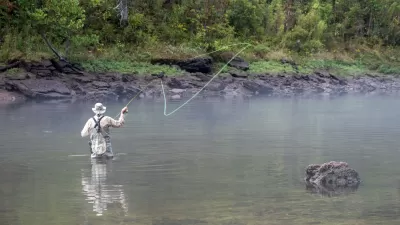And now those property owners are putting barbed wire over the river to keep out "trespassers."

An article by Cassidy Randall has raised the national profile of a battle over public access to streams taking place in New Mexico.
Up until recently, "the fate of public waterways has largely flown under the radar" in New Mexico, writes Randall. "Now New Mexico has become a battleground for that very issue, with the state government, landowners, and outfitters on one side of the fight and anglers, boaters, recreationalists and heritage users on the other. At the heart of the argument: who owns the water that has long been considered the lifeblood of the arid west."
Boaters and fishermen have long known that there are places you can't step on shore, but you're still free to float down the river. Commercial whitewater rafting outfits implement quiet zones along stretches of rivers where private landowners have raised concerns about commercial operators passing by. "Private landowners have long taken unsanctioned steps to keep the public out of waterways, as in the recent case of an Arizona man convicted of shooting at kayakers boating down a river that runs through his land," according to Randall. So what's different about New Mexico's case?
According to Randall, "in the last hours of 2015, efforts to bar public access received official sanction, when New Mexico’s state government quickly and quietly passed a bill that implies private ownership of public waters that run through private land."
"The rule remained mostly dormant until late December, when in a special meeting with only 10 days’ notice – just a third of the 30-day standard – the state began a process to allow landowners to certify streambeds as private property," adds Randall. That has led to landowners placing barbed wire across rivers, like in an example described in the article on the Pecos River.
FULL STORY: Who owns water? The US landowners putting barbed wire across rivers

Planetizen Federal Action Tracker
A weekly monitor of how Trump’s orders and actions are impacting planners and planning in America.

Maui's Vacation Rental Debate Turns Ugly
Verbal attacks, misinformation campaigns and fistfights plague a high-stakes debate to convert thousands of vacation rentals into long-term housing.

San Francisco Suspends Traffic Calming Amidst Record Deaths
Citing “a challenging fiscal landscape,” the city will cease the program on the heels of 42 traffic deaths, including 24 pedestrians.

Defunct Pittsburgh Power Plant to Become Residential Tower
A decommissioned steam heat plant will be redeveloped into almost 100 affordable housing units.

Trump Prompts Restructuring of Transportation Research Board in “Unprecedented Overreach”
The TRB has eliminated more than half of its committees including those focused on climate, equity, and cities.

Amtrak Rolls Out New Orleans to Alabama “Mardi Gras” Train
The new service will operate morning and evening departures between Mobile and New Orleans.
Urban Design for Planners 1: Software Tools
This six-course series explores essential urban design concepts using open source software and equips planners with the tools they need to participate fully in the urban design process.
Planning for Universal Design
Learn the tools for implementing Universal Design in planning regulations.
Heyer Gruel & Associates PA
JM Goldson LLC
Custer County Colorado
City of Camden Redevelopment Agency
City of Astoria
Transportation Research & Education Center (TREC) at Portland State University
Jefferson Parish Government
Camden Redevelopment Agency
City of Claremont




























